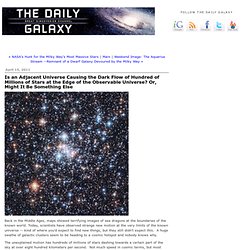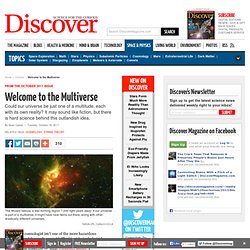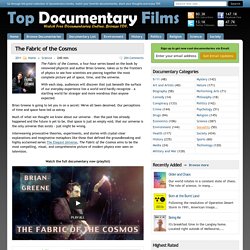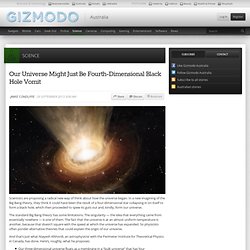

How to map the multiverse - space - 04 May 2009. BRIAN GREENE spent a good part of the last decade extolling the virtues of string theory.

He dreamed that one day it would provide physicists with a theory of everything that would describe our universe - ours and ours alone. His bestselling book The Elegant Universe eloquently captured the quest for this ultimate theory. "But the fly in the ointment was that string theory allowed for, in principle, many universes," says Greene, who is a theoretical physicist at Columbia University in New York. In other words, string theory seems equally capable of describing universes very different from ours.
Multiverse. Top 5 Reasons We Might Live in a Multiverse. The universe we live in may not be the only one out there.

In fact, our universe could be just one of an infinite number of universes making up a "multiverse. " Though the concept may stretch credulity, there's good physics behind it. And there's not just one way to get to a multiverse — numerous physics theories independently point to such a conclusion. In fact, some experts think the existence of hidden universes is more likely than not. Here are the five most plausible scientific theories suggesting we live in a multiverse: 1. Scientists can't be sure what the shape of space-time is, but most likely, it's flat (as opposed to spherical or even donut-shape) and stretches out infinitely. So if you look far enough, you would encounter another version of you — in fact, infinite versions of you. 2.
In addition to the multiple universes created by infinitely extending space-time, other universes could arise from a theory called "eternal inflation. " 3. Is an Adjacent Universe Causing the Dark Flow of Hundred of Millions of Stars at the Edge of the Observable Universe? Or, Might It Be Something Else. Back in the Middle Ages, maps showed terrifying images of sea dragons at the boundaries of the known world.

Today, scientists have observed strange new motion at the very limits of the known universe -- kind of where you'd expect to find new things, but they still didn't expect this. A huge swathe of galactic clusters seem to be heading to a cosmic hotspot and nobody knows why. Welcome to the Multiverse. Theoretical cosmologist isn’t one of the more hazardous occupations of the modern world.

The big risks include jet lag, caffeine overdose, and possibly carpal tunnel syndrome. It wasn’t always so. On February 17, 1600, Giordano Bruno, a mathematician and Dominican friar, was stripped naked and driven through the streets of Rome. Then he was tied to a stake in the Campo de’ Fiori and burned to death. The records of Bruno’s long prosecution by the Inquisition have been lost, but one of his major heresies was cosmological. These days, cosmologists like me may be safer, but our ideas have grown only more radical. Also like Bruno, cosmologists are reaching far beyond what observational evidence can tell them.
The extent of what astronomers can see is frustratingly limited by the speed of light: one light-year (about six trillion miles) per year. The multiverse in three parts: Brian Greene at TED2012. Photo: James Duncan Davidson Superstring theorist and physicist and the co-founder of the World Science Festival, Brian Greene splits his visually rich, action-packed talk into three distinct sections, all in the name of convincing us of the existence of the multiverse, the possibility that way beyond the earth, the milky way, we’ll find that our universe is part of a vast complex of universes we call the multiverse.

Part One: The history and mystery In 1929, the astronomer Edwin Hubble discovered that distant galaxies were rushing away from us; that space was stretching and expanding. This was a revolutionary idea; the prevailing wisdom to that point had been that the universe was static. The Fabric of the Cosmos. The Fabric of the Cosmos, a four-hour series based on the book by renowned physicist and author Brian Greene, takes us to the frontiers of physics to see how scientists are piecing together the most complete picture yet of space, time, and the universe.

With each step, audiences will discover that just beneath the surface of our everyday experience lies a world we'd hardly recognize - a startling world far stranger and more wondrous than anyone expected. Brian Greene is going to let you in on a secret: We've all been deceived. Our perceptions of time and space have led us astray. Nova Fabric of the Cosmos Universe or Multiverse full video. MIT: "New Universes are Being Constantly Created"
In this view, “nature gets a lot of tries — the universe is an experiment that’s repeated over and over again, each time with slightly different physical laws, or even vastly different physical laws,” says Jaffe.

Some of these universes would collapse instants after forming; in others, the forces between particles would be so weak they could not give rise to atoms or molecules. However, if conditions were suitable, matter would coalesce into galaxies and planets, and if the right elements were present in those worlds, intelligent life could evolve. Some physicists have theorized that only universes in which the laws of physics are “just so” could support life, and that if things were even a little bit different from our world, intelligent life would be impossible. In that case, our physical laws might be explained “anthropically,” meaning that they are as they are because if they were otherwise, no one would be around to notice them.
The Daily Galaxy via MIT News Office. Our Universe Might Just Be Fourth-Dimensional Black Hole Vomit. Scientists are proposing a radical new way of think about how the universe began.

Microwave radiation map hints at other universes - space - 17 December 2010. Update on 16 August 2011: The researchers ran additional statistical checks on the CMB data, looking at the probability that the bubbles would appear anywhere on the sky.

Lead author Stephen Feeney says: "The current data favour no bubble collisions. However, a non-zero number of bubble collisions is still allowed, and there are four patches in the WMAP data where [signals of possible bubble universes] are higher than anything we expect from systematic errors due to instrumental effects, foreground-removal artefacts etc. With data from Planck we expect our pipeline to be sensitive to much weaker collision signals, so we should be able to test whether there is something there or whether they're just weird patches of CMB. " The updated analysis appears in Physical Review Letters (DOI: 10.1103/PhysRevLett.107.071301). Original story published 17 December 2010: Collisions between our cosmos and other universes may have left round "bruises" in a map of ancient cosmic radiation.
Hot and cold.